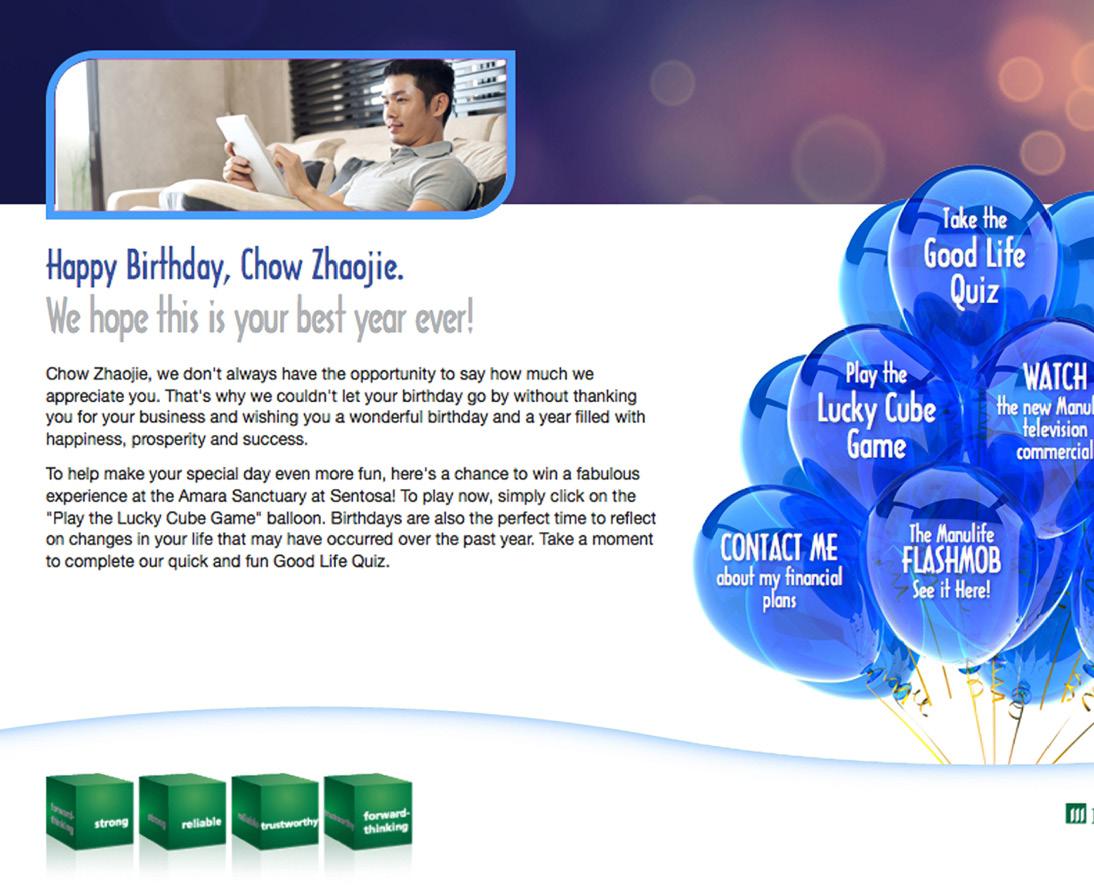
9 minute read
Bringing the Rain
On the journey to realising a digital transformation, printers find that there are plenty of solutions to transform their business model, but the extension of integrated digital services to their service offering proves more challenging. One company in Southeast Asia is working to help print providers with this aspect of their business.
It’s a problem that demands attention sooner rather than later. Razor thin margins and stiff competition for a share of everdecreasing printing budgets are forcing print providers to look for new ways to maintain profitability while retaining customer loyalty. One solution is to elevate your position in the marketing value chain by integrating print with other channels, providing additional services from campaign inception and strategy to program execution. But how does a printer transition from Print Services Provider to Marketing Services Provider? More importantly, in a sea of MSPs all offering the same tactics, how do they do it in a way that makes their company stand out? PURLDIVER is working with Southeast Asian printers to help them make this change, and lift their bottom line. In a recent study by Demand Metric and Printing for Less in the US, over half of respondents had integrated direct mail into their multichannel campaigns with 80 percent reporting that direct mail improved their multichannel campaign performance. This mirrors Marketo’s findings where 79% of consumers say they are only likely to engage with an offer if it has been personalised to reflect previous purchases. prldvr com shape the input – shape the outcome So how does a Printer or an MSP take advantage of this phenomenon? What expertise is required? What new software is needed? Where do you find the experience to provide some of the more complex programs? How are those new services confidently sold in to existing and new customers? PURLDIVER is working with Southeast Asian printers to help them make this change to their bottom line. We caught up with Bob Pente, the Managing Director of PURLDIVER to get the answers to these questions and a few others. PI: What do you mean when you say you are “Bringing the Rain”? BP: A lot of printers today are grinding away every day trying to increase sales. They cling to the idea of doing what they have always done – just more of it – and hoping for a different result. That way lies madness. The print market as we knew it 30 years ago – hey even 15 years ago, has changed and we’re never going back to those times. Marketing has changed, and print is being dragged along with it. Direct marketers today are using the online channels to reach and then engage customers and prospects. Just look at the channels you, yourself, scan every day. Ads on Facebook, Instagram and Google are determined by the last thing you searched for, or clicked on, and they follow you seemingly forever. And a single impression costs a magnitude of 10X less than a print piece with the same offer, maybe even less than that. That’s hard for a marketer to resist, and it’s a battle a printer will never win. Instead of fighting it, we help printers integrate print into the marketer’s online continuum, and in the process, we repatriate a large chunk of that marketer’s business. Business that until now, was going to online marketing firms. We help them formulate the proposal, pitch the customer, and then we put together the strategy and creative. Finally, we give that printer access to the software they need to make it all run flawlessly. The result is a repeatable, sustainable campaign and a loyal, repeat customer. PI: Aren’t agencies and marketing firms already doing that for their clients? BP: Not really. The agency will always choose the path of least resistance, and online marketing represents the greatest profit for them with the least amount of campaign overhead. An online campaign is faster to put up and costs less. But that campaign lacks in its targeting and the level of engagement that it elicits. The result is a lower return on investment. It’s still high enough
Advertisement
Something Special just for you on your birthday!

Happy Birthday Stephen

Manulife Singapore used tailored marketing to turn a brand relaunch into a multi-channel cross-sell/upsell opprortunity with response rates over 20%!

that it could be called successful, and its safe – everyone is doing what they’ve always done, so no one jeopardises their job, but it has nowhere near the return that an integrated, multi-channel campaign delivers. PI: Isn’t there already software on the market that a printer or an MSP can buy and offer the same thing? BP: Sure. But software alone won’t save you. Anybody with a MailChimp account can run a personalised email campaign these
A fully tailored campaign can be successful with the variables commonly found on a business card. days. It’s easy and it’s free. It’s also completely ineffective. Consumers have learned that it’s just software, and the company that’s pitching them doesn’t really know them – or, for that matter, care about them. And that last point is actually the only point. Consumers have come to expect and demand that the companies they do business with take the time to know them and appreciate them. They don’t expect deep discounting or special deals every time they interact with a company, but they do want to be recognised, and they reward the companies that get this right with their business. I’ve seen this over and over, all over the world, in different verticals. It’s a universal truth. PI: So, you integrate print with online marketing, and I get how that has value, but why is it important to personalise the marketing message so completely? BP: The term that’s generating a lot of buzz these days is hyperpersonalisation, but even that is a bit of a misnomer, because most marketers don’t go deep enough. To be truly successful at building a relationship with a customer, a company has to engage the individual on that person’s terms, not the marketer’s. In doing so, they gain that customer’s tacit approval and a chain of collaboration is established. Instead of personalising a marketing message, we are building a buyer/seller relationship for that individual that encompasses as many aspects of their reality as possible. A better description might be Tailored Marketing. For instance, it stands to reason that an insurance company that simply dumps the same offer on the Internet to thousands of people, with only first name or maybe two or three points of personalisation is not going to be as effective as a campaign for an insurance product that recognises that a mother of two young children has different motivations to buy than a mid-sixties widower who wants to leave a legacy for his grandchildren. Not only that, but there are likely different products that are appropriate to each that should be offered. We’ve done multi-channel campaigns in Malaysia, Singapore, Australia and North America that have pulled much, much higher response rates than their side by side traditional direct marketing control cells. PI: What software do you guys at PURLDIVER use for your campaigns? BP: We’ve been using something called XMPie since it launched, for the smallest to the largest of our campaigns. We’ve tried other software suites in the past, but

We helped a major Canadian telecom brand generate double digit response rates for years, engaging B2B prospects across multiple channels for multi-million dollar installations.


nothing comes close in terms of its robustness and its breadth of application. We can generate completely individualised print with personal QR codes to drive targets across channels and support them in any online channel as they arrive, with fully personalised websites, email, offers, selling arguments and creative executions. And given that not everyone buys on the same cycle, XMPie will also nurture that contact, growing it at the speed dictated by the customer. There is simply nothing like it in the market. In fact, we believe in it so much, that we became re-sellers this year, so now we can help a printer sell the concept to their customer, conceive and design a proof of concept and install and manage the program completely inside the printer’s infrastructure. In the process, the printer can learn our methods to move forward on his own or he can keep us as a white labelled resource. Either way, he becomes a high-value asset for his customer and grows his business. PI: The process sounds complicated. Is this level of complexity worth it? BP: I’d say so. In the beginning, when we were managing the 1to1 Lab for Xerox and the 1:1 Experience for Fuji Xerox in Asia and Australia, they were diligent about tracking results beyond simple response rates. We consistently saw ROI numbers that went far beyond anybody’s projections. Not to downplay those response rates, which were also 2 to 3 times those of the control packages. And you have to remember, PURLDIVER does the heavy lifting in terms of complexity. By accepting that complexity, we make it simple for the customer. And a simple path to a sale is always more successful. PI: How does a PSP or an MSP work with PURLDIVER? BP: We work with the printer right from the beginning. We help them identify their customers that will benefit most from a tailored marketing approach and we work with the printer to determine the pitch to that customer. We then help the printer deliver that pitch in the boardroom. In the past, we’ve found that proposing a proof of concept, with a roll-out if it’s successful, is an effective strategy to get customer take-up. Once the client is on board, we work with them to establish a campaign strategy and we design the campaign to achieve the goals of the test, keeping the printer in the loop the whole time. While that is happening, we arrange for installation of XMPie at the printer’s site along with technical training for their operators. Once the campaign is fully approved, we execute from the printer’s site using their operators and we track and report back on results. A successful proof of concept invariably leads to a roll-out. By this point, the campaign is set, so the operator can execute on demand. We have had programs run for years, amortizing that original cost against profit to a tiny expense compared to other tactics. PI: How does a PSP convince their customer to try it? What proof is there that personalisation and multi-channel marketing works? BP: Because of our years of doing tests for Xerox and Fuji Xerox, there are dozens of case studies of our work with objectively measured results from all different verticals. With those proof points, testimonials from client-side program champions and PURLDIVER’s history and presentation, a definitive argument can be made for a test, and with a successful test, a roll-out. The sale of the program concept itself is proven. PI: This has been great. Thanks for giving our readers your time. How can they contact you if they want more detail? BP: They can drop me a note at bob@prldvr.com or call me on +66 658 658 222 and I’ll be happy to discuss it further with them.











